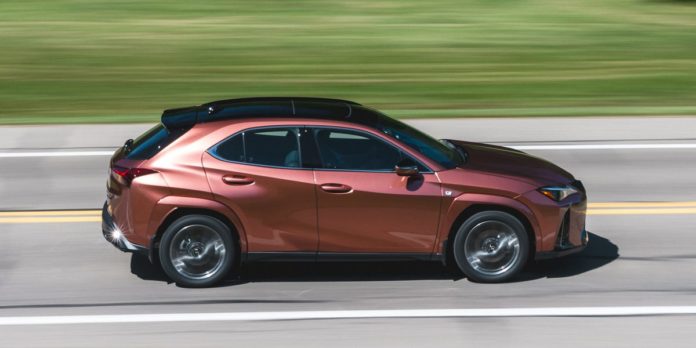At this point, Toyota and Lexus have been playing the hybrid game so long that they’re starting to lap the competition. The pair has hybrid offerings across nearly their entire lineup, and the hybrid drivetrains themselves have gone through multiple iterations. The latest Toyota hybrid setup, which the company calls its fifth-generation system, has now made it into the smallest Lexus, the UX, for 2025.
This powertrain is also found in the Toyota Prius and Corolla Cross, and its main upgrade is more powerful electric motor-generators. In the UX, the combination produces a total of 196 horsepower from the Atkinson-cycle 2.0-liter inline-four and either two or three electric motors. The number of motors depends on whether you choose front- or all-wheel drive (the latter adds a third to the rear axle). With an extra 15 horsepower onboard compared with last year’s model, Lexus saw fit to adjust the car’s badge from UX250h to UX300h.
The powertrain upgrades are welcome, given that the old UX wasn’t exactly a segment leader in terms of either performance or refinement. Acceleration is meaningfully quicker, though not transformed, with our front-wheel-drive UX300h test car reaching 60 mph in 7.7 seconds. That’s a half-second quicker than the 2024 UX250h we tested earlier this year. The gasoline engine still drones under hard acceleration but sounds smoother and less obtrusive, and the handoff between gas and electric is more imperceptible than before.
Despite the extra power, fuel-economy estimates actually rise slightly, with the EPA now rating the front-drive model at 43 mpg combined and the all-wheel-drive model at 42 mpg combined. Those are increases of 1 mpg and 3 mpg over last year’s UX250h. We haven’t yet had the chance to run the UX300h on our real-world highway fuel-economy loop to see how it measures up to the old model’s 35-mpg result.
The UX300h model we tested was the F Sport Handling trim level, which is distinct from the F Sport Appearance trim level in that it includes actual handling-oriented upgrades—that is, it has adaptive dampers. It also incorporates fake engine noises that we found to be silly, as the engine sounds and simulated “shifts” don’t correspond to what’s actually going on under the hood. The F Sport package doesn’t include any changes to the wheel and tire package, though, so the performance uptick at the track isn’t noticeable over the standard model. In our tests, the F Sport Handling actually underperformed the non–F Sport 2024 model, recording 0.79 g on the skidpad and stopping from 70 mph in 185 feet, compared with 0.81 g and 174 feet.
We don’t expect a vehicle like the UX to be an at-the-limit kind of machine, of course, and it offers a pleasant driving experience for everyday commutes and errand running. Ride motions are well controlled, and the steering is nicely weighted. Though it’s not overtly sporty, its tidy size makes it maneuverable and agile, like a good urban runabout should be.
Updates to the UX’s interior over the years have mostly included new screens and infotainment software, and the displays are crisp and nicely rendered. Materials quality is good, and the overall vibe feels appropriately premium compared with other Lexus SUVs. The packaging could be improved, though, as the rear cargo area is small and has a high floor, and the UX has a less spacious rear seat than competitors such as the BMW X1.
Starting under $40,000, the UX300h undercuts every other subcompact luxury crossover on price, but it’s also smaller than its rivals, serving as more of a luxury compact hatchback than a real SUV option. At the $48,795 as-tested price for our well-equipped example, it’s tough to argue for the UX against more spacious and more powerful competition, especially given that the F Sport package doesn’t meaningfully alter how it drives. But in its lower trim levels, the UX strikes us as a nice premium alternative to the related Prius, for those who seek the more prestigious badge or eye-catching styling of the Lexus.
Specifications
Specifications
2025 Lexus UX300h F Sport Handling FWD
Vehicle Type: front-engine, front-motor, front-wheel-drive, 5-passenger, 4-door hatchback
PRICE
Base/As Tested: $45,955/$48,795
Options: head-up display, $900; Copper Crest paint, $595; illuminated doorsills, $425; Obsidian roof paint, $350; mudguards, $165; carpeted cargo mat, $140; Cold Area package (windshield de-icer), $100; rear bumper appliqué, $90; wireless phone charger, $75
POWERTRAIN
DOHC 16-valve 2.0-liter Atkinson-cycle inline-4, 150 hp, 139 lb-ft + 2 AC motors, 111 hp, 152 lb-ft (combined output: 196 hp; 0.5-kWh [C/D est] lithium-ion battery pack)
Transmission: continuously variable automatic
CHASSIS
Suspension, F/R: struts/multilink
Brakes, F/R: 12.0-in vented disc/11.1-in disc
Tires: Bridgestone Turanza EL450
225/50RF-18 95V M+S RFT
DIMENSIONS
Wheelbase: 103.9 in
Length: 177.0 in
Width: 72.4 in
Height: 59.8 in
Passenger Volume, F/R: 47/37 ft3
Cargo Volume: 17 ft3
Curb Weight: 3457 lb
C/D TEST RESULTS
60 mph: 7.7 sec
1/4-Mile: 15.8 sec @ 90 mph
100 mph: 20.6 sec
Results above omit 1-ft rollout of 0.3 sec.
Rolling Start, 5–60 mph: 7.9 sec
Top Gear, 30–50 mph: 4.3 sec
Top Gear, 50–70 mph: 5.3 sec
Top Speed (gov ltd): 111 mph
Braking, 70–0 mph: 185 ft
Roadholding, 300-ft Skidpad: 0.79 g
C/D FUEL ECONOMY
Observed: 40 mpg
EPA FUEL ECONOMY
Combined/City/Highway: 43/45/41 mpg
C/D TESTING EXPLAINED
Despite being raised on a steady diet of base-model Hondas and Toyotas—or perhaps because of it—Joey Capparella nonetheless cultivated an obsession for the automotive industry throughout his childhood in Nashville, Tennessee. He found a way to write about cars for the school newspaper during his college years at Rice University, which eventually led him to move to Ann Arbor, Michigan, for his first professional auto-writing gig at Automobile Magazine. He has been part of the Car and Driver team since 2016 and now lives in New York City.

